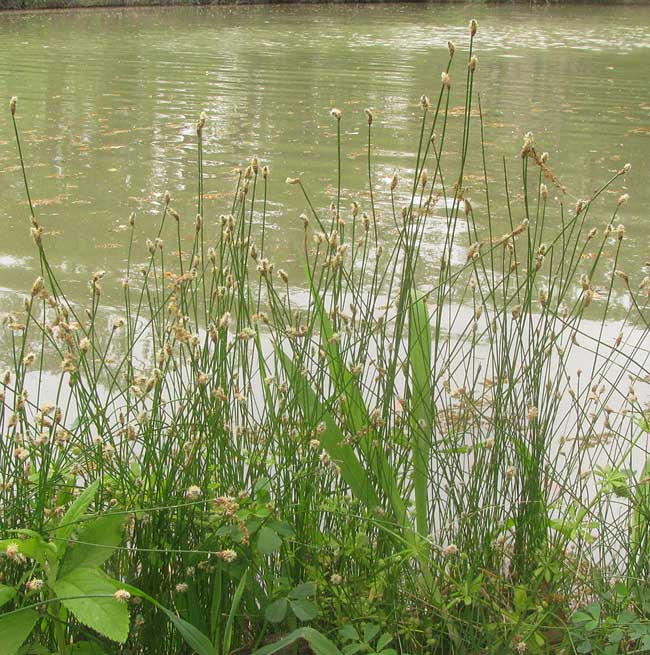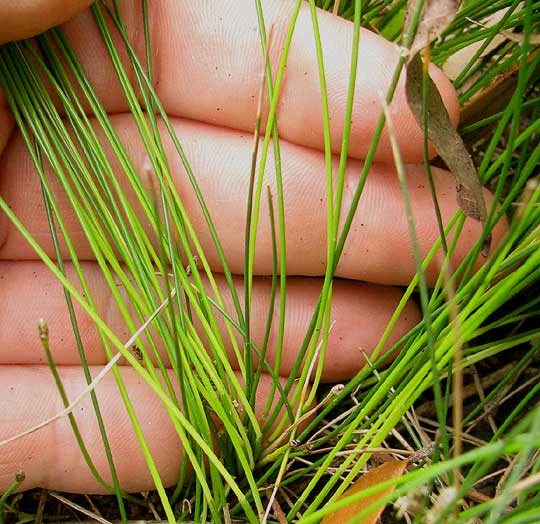Excerpts from Jim Conrad's
Naturalist Newsletter

from the April 20, 2014 Newsletter issued from the Frio Canyon Nature Education Center in the valley of the Dry Frio River in northern Uvalde County, southwestern Texas, on the southern border of the Edwards Plateau; elevation ~1750m (~5750 ft); N29.62°, W99.86°; USA
SANDY SPIKERUSH
In mud beside a small lagoon at Cooks Slough Sanctuary and Nature Park on Uvalde's south side there was a dense, mat-forming stand of spikerushes, a small part of which is shown above.
Spikerushes are members of the Sedge Family, the Cyperaceae, and the genus Eleocharis. They differ from other members of the family by producing flowers packed closely together into short, cylindrical spikes at the tips of slender, leafless stems, which are round in cross-section, not three-sided like some members of the family. A view of this spikerush's wiry,lower stems is seen below:

Spikerushes occur worldwide, and the Flora of North America treats 67 species for North America. So, which species is this?
We've already identified two spikerush species in our area. Along the Dry Frio there's the very small Eleocharis geniculata shown at http://www.backyardnature.net/n/h/eleochar.htm, and the much larger and less common Eleocharis cellulosa, shown at http://www.backyardnature.net/n/h/gc-spike.htm. This species from the Coastal Plain is different from those, and here are some of its distinguishing field marks:
First, its height is intermediate to the two above species, about 15 inches high (40cm). Also, for its height, its stems are extremely slender and stiff, and its more-or-less egg-shaped spikes are very short, adding only a tiny bit of extra height to the plant. Below, a close-up of a spike shows other noteworthy features:

In that spike the flowers -- one flower arising behind each fingernail-like scale -- are at different stages of development. The top, least mature ones each issue three style branches from behind their scale, these deployed to catch pollen for the ovary behind the scale. If you look closely you can see that the lower the styles occur on the spike, the browner and more dried-out looking they are. However, flowers in the spike's center are just beginning to issue pollen-producing, yellow anthers, which dangle on their filaments, but even they, on the lowest flowers, are beginning to darken, dry out and shrivel. When the spike is mature, all style branches and anthers will have fallen off.
Also, notice that the scales are rounded above, not sharp-pointed like scales on some species, and that the scales' margins are transparently pale, like cellophane, but just inside the whitish margins the scales exhibit a broad band of dark purple, which is a little unusual for a spikerush scale.
Normally to be sure about a spikerush ID the tiny, achene-type fruit, or grain is examined. Our Uvalde plants were too immature for there to be grains, but a flower's ovary displays many of the features it will have when it matures into a grain, so some flowering spikes were snipped off, carried back to Juniper House, and studied below the dissecting scope. They're shown below:

In that picture the longish, banana-like items are anthers. The slender, whitish, string-like things are "perianth bristles" arising from the ovaries' bases. The roundish, greenish things on the left side of the picture are the grains. Notice that atop each grain there's a flattish, spade-shaped item. Those are "tubercles," and tubercle size relative to the grain, and their shape, vary tremendously from species to species, so they are important features. Just as important to notice is that the grains are flat on one side, but roundish on the other. Such grains are said to be three sided, and they bear 3-branched styles. The many spikerush species fall into one of two broad categories: those with two convex sides so that they are lens-shaped and have two style branches; or else with three sides like ours.
All these details lead us to our plant's identity. Sometimes called the Sand Spikerush, it's ELEOCHARIS MONTEVIDENSIS, native to warmer parts of the Americas, from Argentina north through Central America and Mexico, into the US, mainly in the southwestern states. It grows in many wet habitats, and apparently has a preference for sandy soils.